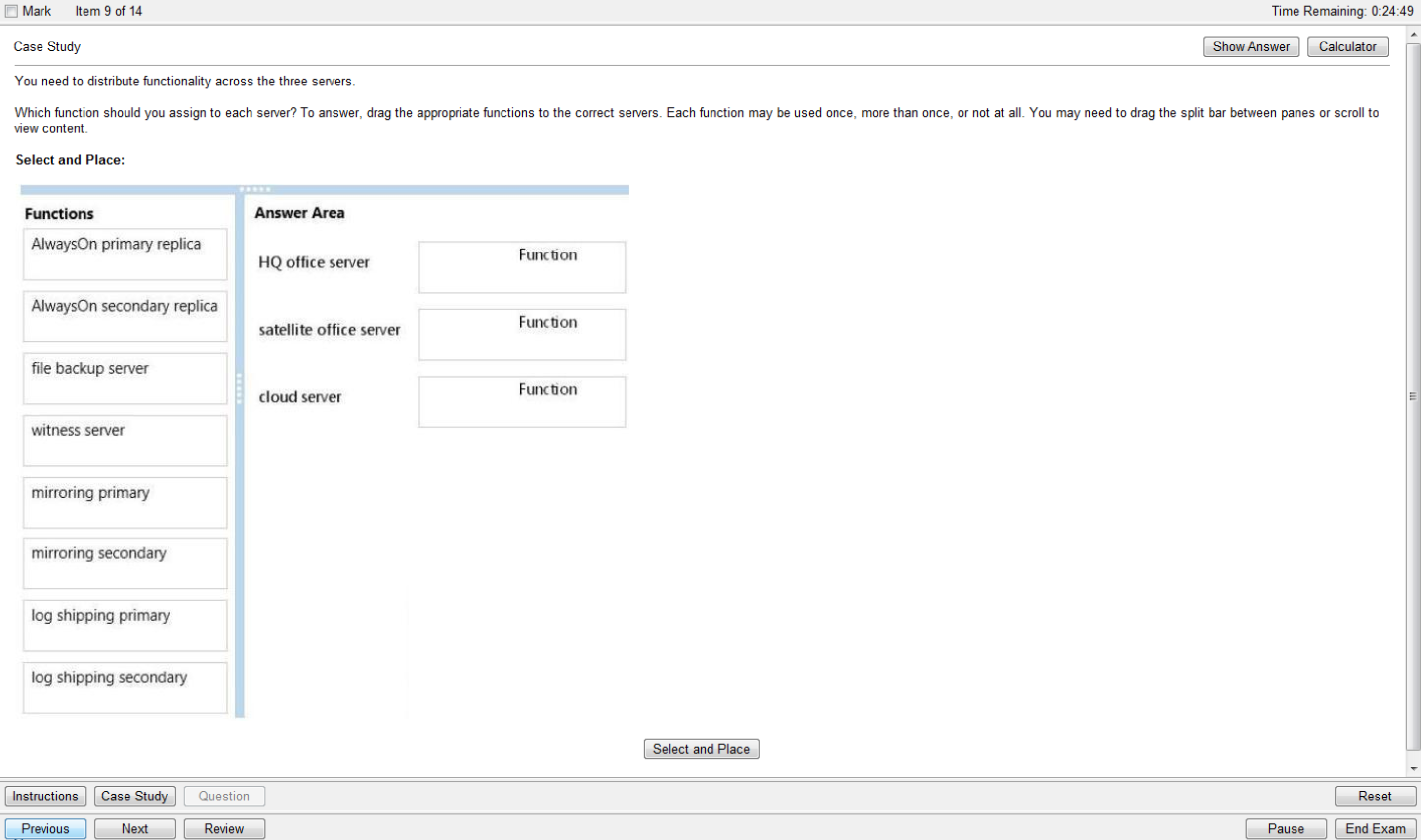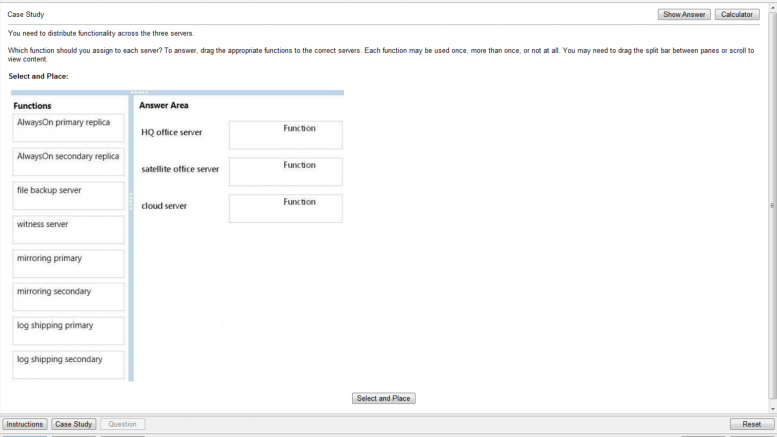How to Pass Microsoft MCTS 70-595 Dumps Exam Easily?
Get the newest Microsoft MCTS 70-595 dumps exam training resources in PDF format download free try from leads4pass. Download Microsoft MCTS real https://www.leads4pass.com/70-595.html exam questions and verified answers. If you are looking to get TS: Developing Business Process and Integration Solutions by Using Microsoft BizTalk Server 2010 certification by passing exam 70-595 then you can pass it in one go.
Best Microsoft MCTS 70-595 dumps pdf training resources: https://drive.google.com/open?id=1HwprFnZvePMkwmtzujWw8DvA7CUbfo09
Best Microsoft MCTS 70-494 dumps pdf training resources: https://drive.google.com/open?id=1jnwjNKN–gDhfKE9DzlLZMMojOtEWKbh
The best Microsoft 70-243 dumps exam practice questions and answers update, download the best useful Microsoft exam software to have a free try.

New Microsoft MCTS 70-595 Dumps Exam Questions And Answers (1-15)
QUESTION 1
You are developing a BizTalk Server 2010 orchestration. In the Business Rule Composer, you create and save a policy named BonusPolicy that calculates an employees bonus based on year- to-date sales. You add a Call Rules shape to the orchestration. In the BizTalk Orchestration Designer, BonusPolicy is not listed in the menu of available policies to call. You need to make the policy available in the Orchestration Designer.
What should you do?
A. Use the Rule Engine Deployment Wizard to export BonusPolicy.
B. In the Business Rules Composer, publish BonusPolicy.
C. In the Business Rules Composer, create a vocabulary with a definition that references the XML schema used to evaluate BonusPolicy. Publish the vocabulary.
D. In the Business Rules Composer, use the Rule Store menu and load policies from the BizTalkRuleEngineDb database.
Correct Answer: B
QUESTION 2
You use BizTalk Server 2010 to send EDI purchase orders to three trading partners. All of the trading partners use the same version of the purchase order message but define custom codes for the product types. The trading partners confirm purchase order acknowledgements by email instead of through response messages. The standard purchase order schemas included with BizTalk do not include the custom product type codes for each trading partner. You need to ensure that each trading partners purchase order schema is the schema that is used for orders that are sent to them.
What should you do?
A. Under the transaction set settings for the party, define an envelope for each trading partner. For the namespace, use the custom namespace you defined for each BizTalk schema.
B. Under the transaction set settings for the party, define a local host setting for each trading partner. For the namespace, use the custom namespace you defined for each BizTalk schema.
C. Under the transaction set settings for the party, define an envelope for each trading partner. For the namespace, use the default namespace defined by BizTalk for EDI messages.
D. Under the transaction set settings for the party, define a local host setting for each trading partner. For the namespace, use the default namespace defined by BizTalk for EDI messages.
Correct Answer: A
QUESTION 3
A BizTalk Server 2010 solution uses Business Activity Monitoring (BAM) to collect business information. The solution contains a BAM view named OrderView. After you deploy the view, application users can log on to the BAM portal but the OrderView view does not appear to them. You need to ensure that the BAM portal displays the OrderView view to application users.
What should you do?
A. Use the BizTalk Tracking Profile Utility (bttdeploy.exe) to redeploy the tracking profile used in this solution.
B. Use the Business Activity Monitoring Utility (bm.exe) to add a subscription for the OrderView view.
C. Create a Microsoft SQL Server logins for the users on the server that hosts the BAMPrimaryImport database.
D. Use the Business Activity Monitoring Utility (bm.exe) to grant the users access to the OrderView view.
Correct Answer: D
QUESTION 4
A BizTalk Server 2010 application is designed to receive a file from a customer. The customer periodically updates the file on an FTP site. The file has a name that never changes. You have been given read-only permissions to the site. You need to create a receive location that detects when the file has been updated and then retrieves it. You use the BizTalk Administration console to create a receive port.
What should you do next?
A. Create an FTP receive location with the site and credential information. In the FTP adapter properties, set the Delete After Download property to Yes and set the Enable Timestamp Comparison property to Yes.
B. Create an FTP receive location and set the Target File Name property to *.*.
C. Create an FTP receive location with the site and credential information. In the FTP adapter properties, set the Delete After Download property to No and set the Enable Timestamp Comparison property to Yes.
D. Create an FTP receive location and set the Mode property to Passive.
Correct Answer: C
QUESTION 5
A company uses BizTalk Server 2010 to receive electronic orders from multiple customers. You have schemas for all the order formats that the customers send. You need to create a business process that handles an incoming order. You create a canonical schema that represents an order. You also create an orchestration that handles an order of the canonical schema.
What should you do next?
A. Create maps from each of the customer order formats to the canonical schema. Create a receive port and location and bind the port to the orchestration. Use the maps on the receive port.
B. Create maps from each of the customer order formats to the canonical schema. Create a send port and bind it to the orchestration. Use the maps on the send port.
C. Create maps from the canonical schema to each of the customer order formats. Create a send port and bind it to the orchestration. Use the maps on the send port.
D. Create maps from the canonical schema to each of the customer order formats. Create a receive port and location and bind the port to the orchestration. Use the maps on the receive port.
Correct Answer: A
QUESTION 6
A supplier sends messages that they sign with a certificate to a BizTalk Server 2010 application. You need to ensure that the received messages are signed with the certificate.
What should you do?
A. Use the XMLTransmit pipeline.
B. Use a custom pipeline that leverages the MIME/SMIME encoder component.
C. Use a custom pipeline that leverages the MIME/SMIME decoder component.
D. Use the XMLReceive pipeline.
Correct Answer: C
QUESTION 7
In a Microsoft Visual Studio solution, you include an existing shared BizTalk Server 2010 project that is used by more than one BizTalk application. You specify that the shared BizTalk project will be deployed to the same BizTalk application as the other BizTalk projects in the solution. During deployment of the BizTalk project from Visual Studio, you receive the following error: Failed to add resource(s). Resource (-Type=”System.BizTalk:BizTalkAssembly” – Luid=”Contoso.SharedComponent, Version=1.0.0.0, Culture=neutral, PublicKeyToken=c4b6d1ca34bb90c0″) is already in store and is either associated with another application or with another type. You need to deploy the projects of the solution that reference the shared BizTalk project without errors.
What should you do?
A. Open Configuration Manager and clear the Deploy check box for all BizTalk projects. Then build and deploy the solution.
B. Use the BizTalk Administration console to import a copy of the MSI package of the shared component into every BizTalk application.
C. Use the BizTalk Administration console to export the assemblies as a Microsoft Windows Installer (MSI) package for the BizTalk solution.
D. Open Configuration Manager and clear the Deploy check box for the shared BizTalk project. Then build and deploy the solution.
Correct Answer: D
QUESTION 8
You are configuring a BizTalk Server 2010 environment with one server running Microsoft SQL Server for the BizTalk databases and Enterprise Single Sign-On (SSO) store. There are two BizTalk servers. All software has been installed. Both BizTalk servers will share a BizTalk group. You need to complete the installation in this environment. You start the BizTalk Server Configuration wizard on both BizTalk servers.
What should you do next?
A. On BizTalk Server 1, select and apply Basic Configuration. On BizTalk Server 2, select and apply Basic Configuration.
B. On BizTalk Server 1, select Custom Configuration. Create a new SSO system and BizTalk group on the server running SQL Server. On BizTalk Server 2, select Custom Configuration. Create a new SSO system and BizTalk group on the server running SQL Server.
C. On BizTalk Server 1, select Custom Configuration. Create a new SSO system and BizTalk group on the server running SQL Server. On BizTalk Server 2, select and apply Basic Configuration.
D. On BizTalk Server 1, select Custom Configuration. Create a new SSO system and BizTalk group on the server running SQL Server. On BizTalk Server 2, select Custom Configuration. Join the existing SSO system and BizTalk group.
Correct Answer: D
QUESTION 9
A BizTalk Server 2010 application is deployed and running. The application has a long-running orchestration with only a single Receive shape that activates the orchestration. There are currently instances of this orchestration in the dehydrated state. You need to make sure that no new orchestration instances are started but that existing instances are allowed to complete.
What should you do?
A. Stop all host instances.
B. Stop the application with the option Partial Stop C Suspend running instances.
C. Suspend any running orchestration service instances.
D. Stop the application with the option Partial Stop C Allow running instances to continue.
Correct Answer: D
QUESTION 10
You are moving a BizTalk Server 2010 application from a development environment to a QA environment for the first time. You export a copy of the BizTalk application and include the bindings. When importing the Microsoft Windows Installer (MSI) file into the QA environment, you receive the following error: Failed to update binding information. (mscorlib)Cannot update send port “LogContosoMessage”. (Microsoft.BizTalk.Deployment)The following items could not be matched up to hosts due to name and/or trust level mismatches:Item: ‘FILE’ Host: ‘ContosoLogHost’ Trust level: ‘Untrusted’ You need to ensure that the MSI file can be imported into the QA environment.
Which artifacts should you create?
A. a host named ContosoLogHost, a host instance that uses the default host, and a FILE receive adapter handler that uses the ContosoLogHost host instance
B. a BizTalk application and a FILE send adapter handler that uses the default host
C. a host named ContosoLogHost, a host instance that uses the ContosoLogHost host, and a FILE send adapter handler that uses the ContosoLogHost host instance
D. a BizTalk application and a FILE send port named LogContosoMessage that uses the default host
Correct Answer: C
QUESTION 11
You change the host-level settings of a BizTalk Server 2010 group named Group1 to optimize the group for a low-latency scenario. You install and configure another BizTalk Server 2010 group, named Group2. Both BizTalk groups use identical hardware. You need to ensure that the same low-latency optimizations are applied to Group2 as to Group1.
What should you do?
A. From Microsoft SQL Server Management Studio, create a backup of the BizTalk management database of Group1. Restore this backup on Group2.
B. From the Administration console, export all applications as Microsoft Windows Installer (MSI) files from Group1. Import the applications on Group2.
C. From the Administration console, export the host-level settings for Group1. Import the settings on Group2.
D. From the Administration console, export the default application as MSI file from Group1. Import the application on Group2.
Correct Answer: C
QUESTION 12
You are developing a BizTalk Server 2010 orchestration that processes messages received from the BizTalk FILE adapter. You need to retrieve the original file name of the message and store it in a variable named FileName for future processing.
What should you do?
A. Inside a message assignment shape in the BizTalk Orchestration Designer, use the WSS.Filename context property to assign the FileName variable.
B. Inside an expression shape in the BizTalk Orchestration Designer, use the LEGACY.FilePath context property to assign the FileName variable.
C. Inside a message assignment shape in the BizTalk Orchestration Designer, use the BTS.MessageType context property to assign the FileName variable.
D. Inside an expression shape in the BizTalk Orchestration Designer, use the FILE.ReceivedFileName context property to assign the FileName variable.
Correct Answer: D
QUESTION 13
A BizTalk Server 2010 solution uses an orchestration to send XML documents to various vendors. The XML documents are delivered by an FTP port. The port is configured in the orchestration with the Binding property set to Specify later.
You need to ensure that the FTP address of the send port can be specified in the orchestration at run time.
What should you do?
A. Create a new send port group. Add a new FTP send port to the send port group for each vendor. Bind the orchestration to this send port group.
B. Configure the Binding property for the port in the orchestration to Direct. Set the value of the Microsoft.XLANGs.Core.PortBinding property for this port in the orchestration to the appropriate vendor address.
C. Configure the Binding property for the port in the orchestration to Dynamic. Set the value of the Microsoft.XLANGs.BaseTypes.Address property for this port in the orchestration to the appropriate vendor address.
D. Configure the Binding property for the port in the orchestration to Specify now. Bind the orchestration to this new port. Set the value of the Microsoft.XLANGs.BaseTypes.Address property for this port in the orchestration to the appropriate vendor address.
Correct Answer: C
QUESTION 14
You are developing a BizTalk Server 2010 orchestration that routes shipping cargo. The orchestrations Transaction Type property has been set to Long Running. Part of the orchestration contains a block of logic for cargo routing. The routing logic is self-contained and makes no external calls that would affect the orchestrations state. You need to ensure that if an exception is thrown, no action taken during the execution of the routing logic block is committed.
What should you do?
A. Add a Scope shape to the orchestration and set its Transaction Type property to None. Add the block of routing logic to the Scope shape.
B. Add a Scope shape to the orchestration and set its Transaction Type property to None. Add a Group shape and add the block of routing logic to it. Place the Group shape in the Scope shape.
C. Add a Scope shape to the orchestration and set its Transaction Type property to Long Running. Add the block of routing logic to the Scope shape.
D. Add a Scope shape to the orchestration and set its Transaction Type property to Atomic. Add the block of routing logic to the Scope shape.
Correct Answer: D
QUESTION 15
A BizTalk Server 2010 solution uses an orchestration that performs several actions. The orchestration uses Expression shapes and Message Assignment shapes. The orchestration has no Scope shapes and the Transaction Type property is set to None. Occasionally, an XLANG exception is thrown in the orchestration. The exception is not handled and the orchestration goes into a suspended state. You need to catch the exception and handle the error.
Which two actions should you perform? (Each correct answer presents part of the solution. Choose two.)
A. Add an exception handler. Set the Exception Object Type property to Microsoft.XLANGs.BaseTypes.XLANGsException.
B. Set the Transaction Type property of the orchestration to Long Running. Set the Compensation property of the orchestration to Default.
C. Add a Scope shape to the orchestration. Place all Expression and Message Assignment shapes within this scope.
D. Add an exception handler. Set the Exception Object Type property to System.SystemException.
Correct Answer: AC
Why Choose leads4pass?
leads4pass is the best provider of IT learning materials and the right choice for you to pass Microsoft 70-595 exam. Other brands started earlier, but the questions are not the newest and the price is relatively expensive. leads4pass provide the latest real and cheapest questions and answers, help you pass Microsoft 70-595 exam easily at first try.

What Our Customers Are Saying:


The best and most updated latest Microsoft MCTS 70-595 dumps pdf training resources which are the best for clearing https://www.leads4pass.com/70-595.html exam test, and to get certified by Microsoft MCTS. You can download Microsoft MCTS 70-595 dumps pdf training material from leads4pass and pass the Microsoft 70-595 exam in the first attempt.
Latest Microsoft MCTS 70-595 dumps vce youtube:
